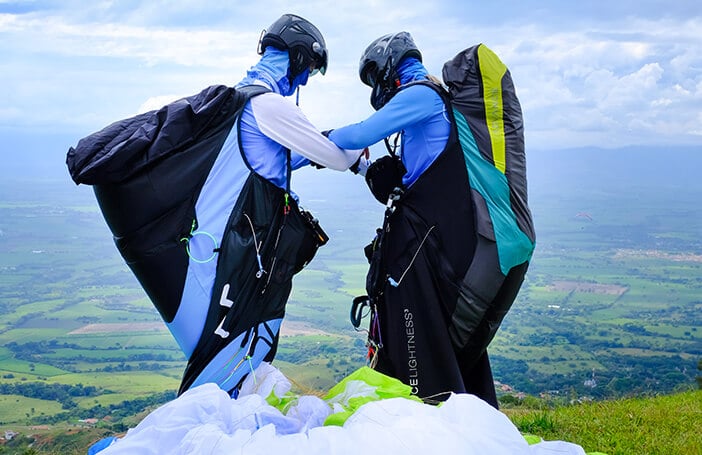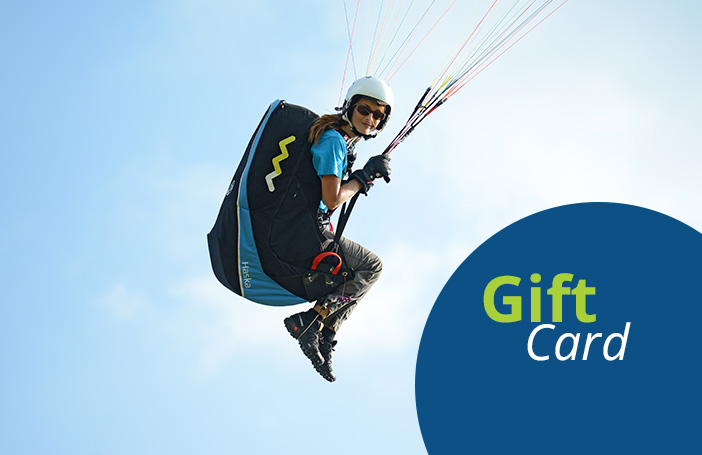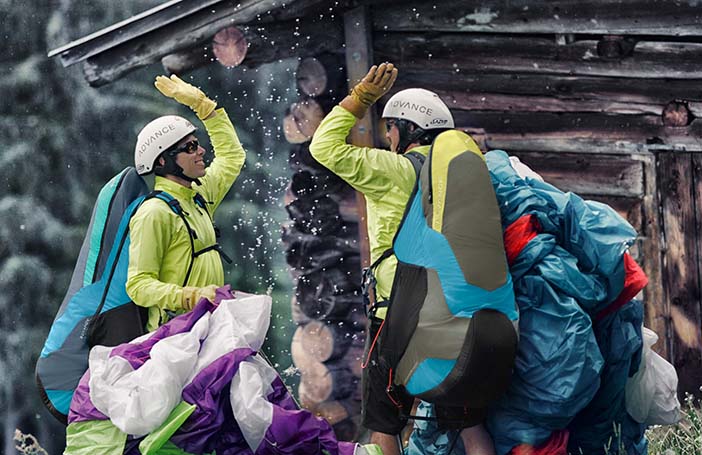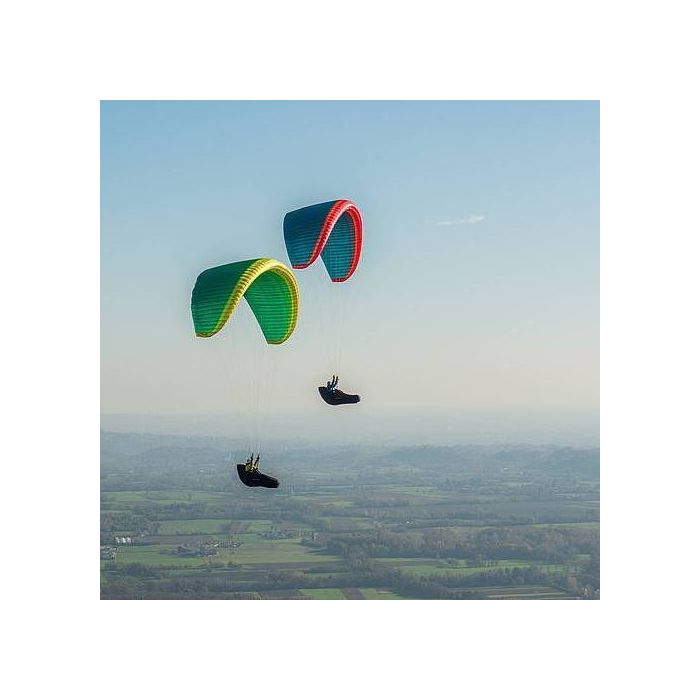
Nova MENTOR 6 (PAST MODEL)
Select all options to view stock availability

Superseded by the Nova MENTOR 7
For many years the MENTOR series has been synonymous with top performance in the EN B class. The MENTOR 6 continues this tradition, complementing the strengths of its predecessors with innovations that enhance its performance even more. Broaden your horizons with the master in its class.
Technical data
Size |
XXS Light |
XS |
S |
M |
L |
| Number of cells | 59 | ||||
| Projected span (m) | 8.5 | 8.9 | 9.4 | 9.8 | 10.2 |
| Projected area (m²) | 18.2 | 20.2 | 22.2 | 24.2 | 26.2 |
| Projected aspect ratio | 3.9 | ||||
| Flat span (m) | 10.8 | 11.4 | 11.9 | 12.4 | 13.0 |
| Flat area (m²) | 21.5 | 23.8 | 26.2 | 28.5 | 30.9 |
| Flat aspect ratio | 5.43 | ||||
| Line diameter (mm) | 0.7 / 0.8 / 1.0 / 1.2 / 1.3 | ||||
| Line length (m) | 6.4 | 6.7 | 7.1 | 7.4 | 7.7 |
| Total line length (m) | 235 | 248 | 260 | 271 | 282 |
| Max. chord (m) | 2.46 | 2.59 | 2.71 | 2.83 | 2.95 |
| Min. chord (m) | 0.44 | 0.47 | 0.49 | 0.51 | 0.53 |
| Weight (kg) | 3.45 | 4.8 | 5.05 | 5.3 | 5.55 |
| Recommended TOW* (kg) | 60-80 | 70-90 | 80-100 | 90-110 | 100-130 |
| Certification (EN/LTF) | B | B | B | B | B |
*TOW: take off weight.
Colours
Standard colours: Blue; Aqua; Green; Red.

Custom colours: Choose your colours here then email us the NOVA colour code with your order.
Scope of delivery
NOVA rucksack. The wing and harness will determine the size of the rucksack. We are offering our high quality and comfortable to carry models in size S (110 litres), M (145 litres) and in L (165 litres).
NOVA windsock. So you know where the wind is coming from, we have added a NOVA windsock. With a length of approximately 80cm it is large enough for a take-off site.
Repair kit. Everyone hopes it will never happen: a hole or tear in the paraglider. We have included a minor damage repair kit in the right colour for such an eventuality.
Manual. We have enclosed a very detailed manual which contains everything you need to know about your flying equipment. Please study it before flying your gear for the first time.
MENTOR 6 - extend your range
High-tech for the EN B Class
Inner values. What makes the MENTOR 6 so special is the increased accelerated glide, smooth trailing edge, new risers, durable but lightweight cloth, aerodynamically optimised 3D-shaped seams and an intuitive handling with less brake pressure. We decided not to place any limitations on our ambition and have added many detailed solutions which are completely new to the EN B class. A sports intermediate for cross-country and fun flying, the MENTOR 6 will help you to reach your goals faster - especially when accelerated.
The MENTOR promise. Maintaining the same aspect ratio and high degree of passive safety, in comparison to the MENTOR 5 we have been able to improve the glide performance and the handling. We were able to achieve both with the use of innovative features such as Zig-Zag 3D-Shaping, the innovative Mini-Rib Vector Tape, Double-B Splits and newly designed risers. The MENTOR 6 handling is very intuitive, it has pleasantly light brake pressure and when circling in a thermal it is both teacher and a wing you can really crank in. The design work on this glider covered the minutest detail but we still recognised the bigger picture: a reworked curvature and a smooth trailing edge when braking give the MENTOR 6 the final polish.
Smart details. Often it is the small changes which have a big impact on the satisfaction we have with a paraglider. On the MENTOR 6 we used internal mini-rib seams and improved cloth to ensure the wing is more resilient and durable when it is in contact with the ground. Another added bonus are the Ronstan ball bearing pulleys on the speed-system, which reduce the effort when accelerating. Additionally, the differentiated A3 riser transmission ensures an optimised wing twist in accelerated flight which makes the wing more stable.
Short and compact
Zig-Zag 3D-Shaping. As well as the double 3D-shaped seams, there is an additional diagonal 3D-shaped seam on every cell. This forms a striking zig-zag pattern. This seam doesn’t run in the direction of the spanwise force. This means the seam runs more cleanly and is more aerodynamically advantageous. This feature reduces creases on the leading edge.
Mini-Rib Vector Tape. Mini-ribs increase the number of cells in the rear wing area and thus provide an aerodynamically more favourable trailing edge. In the MENTOR 6 there is an additional vector tape traversing through a hole in each mini-rib. This tape reduces the crease that is created when braking. In this way both the climb rate and handling are improved. Additionally, there is a brake gathering system on the trailing edge. This means that the MENTOR 6 has a clean, smooth trailing edge even when brake is applied.
Double-B splits. Similar to the double-A splits in two-liners, the double-B splits allow for a better load distribution in the chord direction. This means more stability and fewer creases between the individual line areas.
New risers. The MENTOR 6 risers are a redesign of the Speedbrake Riser. They ensure that the B-line area is also shortened when the C-line area is pulled during accelerated flight. The advantage is that the when using C-steering, there is no performance-limiting crease between the B-line and C-line areas, which is otherwise typical in three-liners. The MENTOR 6 is delivered with these new risers, so there is no need to additionally install the Speedbrake Risers. The new riser is practical and fits comfortably in your hand, whether you are ground handling or preparing to launch. Read more about the new optimised MENTOR 6 risers below.
Ergonomic brake handles. We have developed new brake handles, and the MENTOR 6 is the first wing to be fitted with them. They have an ergonomic shape and are comfortable to use.
Pilot target group
The MENTOR 6 is a paraglider with impressive performance which has – in the hands of an experienced pilot – a very manageable handling and extreme flight behaviour. Flying the MENTOR 6 does require a level of skill. Although certified as EN B, the MENTOR 6 is not suitable for beginners and occasional pilots. But any pilot with the ambition to advance their sound flying knowledge to another level will find a perfect partner in the MENTOR 6. Particularly experienced cross-country pilots who like to fly at top speed for long flights will love the enhanced performance of this glider.
Would you like to know if this is the right wing for you or would you like to test fly one? In both cases the best person to contact is your NOVA dealer, Flybubble.
Technology
Mini-Rib Vector Tape. A vector tape near the trailing edge has various advantages. Firstly, this tape reduces the crease in the upper surface that is created when braking. Secondly, the wing is more compact, i.e. the wing deforms less during glides in moving air. To maximise both these advantages, it was necessary to locate this vector tape very far back in the area of the mini-ribs.
Under pressure. NOVA Air Scoop is an optimised air intake, which increases the internal wing pressure. Nova's Air Scoop principle is similar to the ram-air inlet duct on a sports car: increased airflow produces higher pressure. Higher internal pressure in a paraglider means improved performance through increased structural stability and collapse resistance.
Zig-Zag 3D-Shaping is the next step to an even smoother wing nose. As well as Double 3D-Shaping, two parallel seams which stretch the entire length of the upper surface span, each cell located at the nose has a further diagonal 3D-Shaping seam. This forms a striking zig-zag pattern. This means the seam runs more cleanly and is more aerodynamically advantageous.
More compact. The aspect ratio of a glider is not the only factor in passive safety, but still a very important one. A high aspect ratio favours cravats after asymmetric collapses, generally shortens brake travel and normally makes wings more difficult to fly. Nova's analytical tools permit us to build performance wings even with a low or moderate aspect ratio.
Comfort on the ground. All NOVA paragliders are made to be easy to use. For packing you can use a concertina bag, but it is not essential. Our extensive experience with rods has taught us that the packing method has little influence on the durability of the wing. Bent rods quickly spring back into their original shape.
Light and durable. Paragliders in the Weight-optimised category are lighter than conventional paragliders - but offer the same mechanical stability and durability. These wings are lighter to carry, easier to launch and are therefore suitable for hike & fly. Weight-optimised is aimed at pilots who appreciate light weight without compromising on durability.
Materials
| Leading edge | Dominico 30D, 41 g/m2 |
|---|---|
| Top surface | Dominico 20DPS, 33 g/m2 |
| Lower surface | Dominico 20DPS, 33 g/m2 |
| Profile ribs (suspended) | Porcher Skytex 40 Hard, 40 g/m2 |
| Profile ribs (unsuspended) | Porcher Skytex 40 Hard, 40 g/m2 |
| Main lines | Liros PPSL 191 / U-8000 120 |
| Gallery lines | Edelrid U-8000 / PPSLS 65 |
| Brake lines | PPSLS 65 |
| Risers | Kevlar 12mm |
Optimised MENTOR 6 risers
For the MENTOR 6 we developed a number of performance-enhancing innovations. This is also true for the risers. It has a differentiated A3 riser transmission, as well as a optimised Speedbrake Riser. This offers considerable advantages, especially in accelerated flight. The new riser allows the MENTOR 6's cross-country potential to be fully exploited. This is the summary of everything worth knowing.
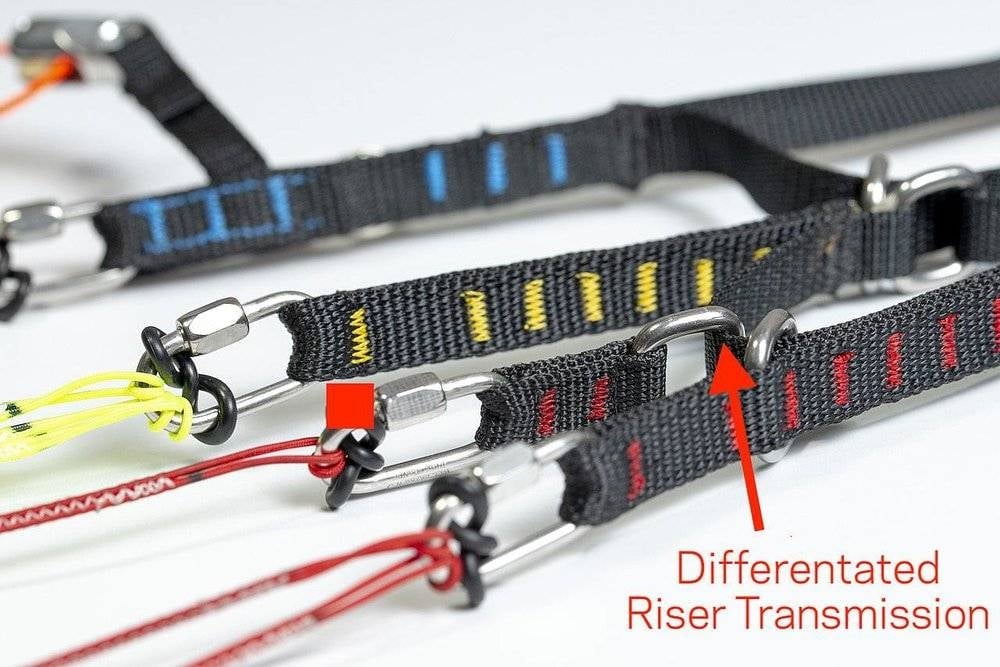
Differentiated A3 riser transmission
In this A-line configuration, there is a speed system runner. If the pilot pushes the speed-bar, the inner Arisers are fully accelerated, while the outer ones are only accelerated by 50%. The wing twist changes and the sail’s tension is increased in the spanwise direction. This has the effect of increasing the stability of the canopy when accelerated and the wing is less prone to collapse.
Optimised MENTOR 6 Speedbrake Riser
The NOVA Speedbrake Riser is the first three-liner riser which permits the glider to be accelerated as well as decelerated. (We deliberately don’t use the word “brake” in this context, because the Speedbrake Riser was designed to be used when accelerating).
Why use the Speedbrake Riser (SBR)? When accelerating, many pilots use the C-lines to compensate for pitch and roll movements. While this works well on two-liners, on a three-liner this causes a distinct performance-limiting crease in the profile (and for this reason we are no fans of C-handles).
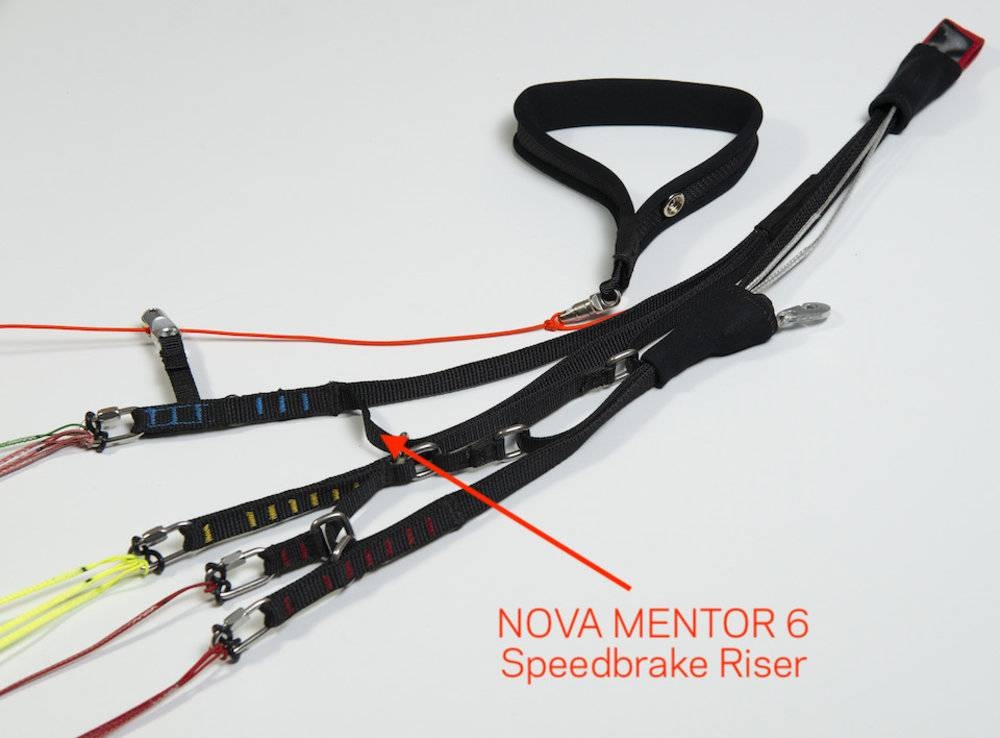
To eliminate this crease, we developed the NOVA Speedbrake Riser in conjunction with our team pilot Robert Schaller, a engineer and enthusiastic crosscountry pilot. In this innovative system, the B and Crisers are connected through a webbing strap and pulley. If the pilot pulls the C-riser back and down in a radius with the carabiner as a pivot point, the B-area shortens, but only by 50%. The wing “decelerates” and remains crease-free and undeformed – and most importantly, there is no loss of performance!
We received a lot of praise for the SBR, and other manufacturers brought similar systems to the market. The idea proved itself.
On the MENTOR 6 risers we optimised the SBR. The connecting strap between the B- and C-area now runs deeper. This has the advantage that a) the hands are a little lower when flying (aerodynamically advantageous and more ergonomic), and b) during strong wind launches, the Crisers can still be used for canopy control.
We are so convinced of the benefits of the MENTOR 6 SBR that we are fitting it as standard. So, the SBR is no longer an optional, extra cost accessory, it comes as standard!
Practical tips
It is important that the pilot should familiarise themselves with the SBR in calm conditions. If the Speedbrake is pulled too much or too suddenly when the wing is already pitched back there is the risk of stall.
Never brake and accelerate at the same time! Using the brakes during accelerated flight is not only detrimental to performance, but (in comparison to non-accelerated flight) it increases the likelihood of collapses Instead, please use the SBR, or compensate for the pitch movement using the speed-bar.
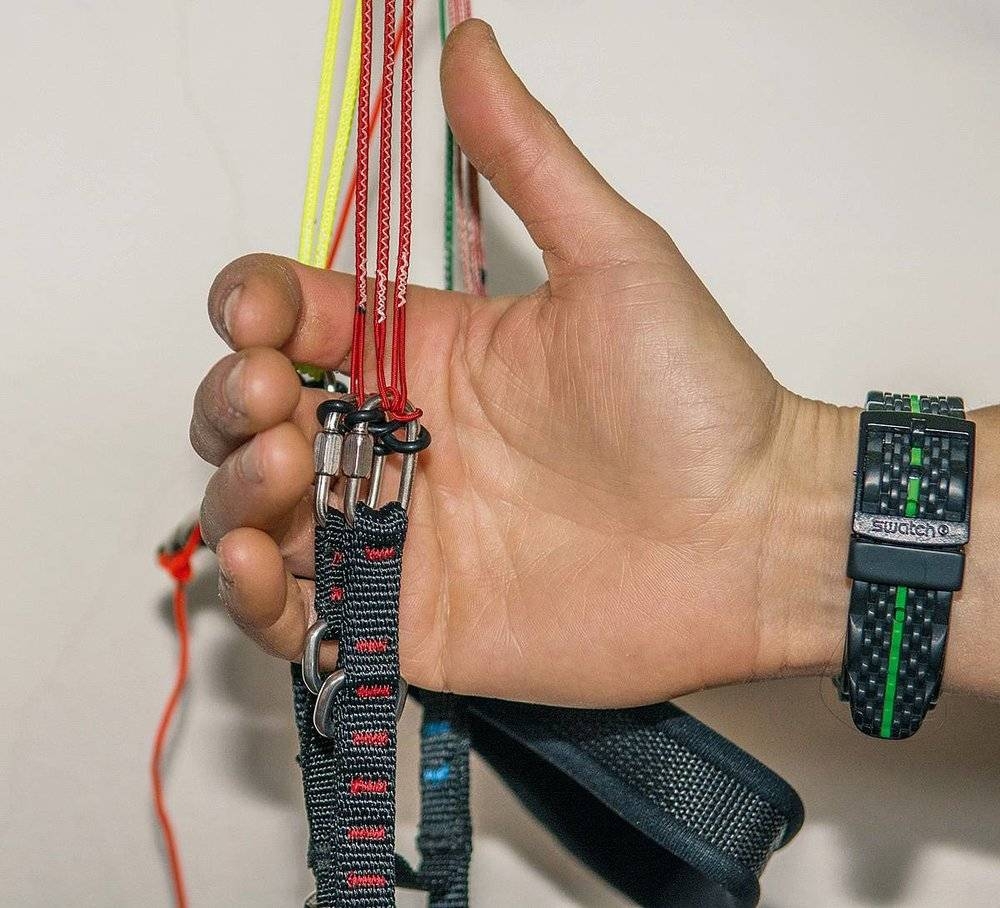
Advice on holding the MENTOR 6 A-riser during take off
When inflating the MENTOR 6 we recommend holding the A-riser directly at the maillons (see image) – NOT the webbing under the maillons. Holding the risers in this way, the MENTOR 6 will launch in an exemplary fashion - wether forward or reverse. The wing climbs cleanly and directly without hanging back or having a tendency to overshoot.
NOT like this: If the risers are held below the maillons, the MENTOR 6 has a tendency to hang back. This is due to the relatively small distance between the Aand B-areas (because of the A3- transmission and the Speedbrake-riser). Too much pull on the B-area brakes the inflation.
Downloads
Certification: XXS | XS | S | M | L
Nova service info & FAQ
Read Nova service info and answers to FAQ.
MENTOR 6 paraglider reviews
"The Mentor 6 is very tolerant of various inputs, and is best suited to first timers in the XC class. It makes a nice progression up from the Nova ION and similar wings." "It is calm, steady, and simple to fly. It doesn’t require fast reactions... " "... if you are going into ‘big air’ for the first time, taking on serious mountain flying like the Alps or Rockies, or feel intimidated by steep launches and a lack of current airtime, this wing will help you get it right while you concentrate on enjoying the view."
- Greg Hamerton, Flybubble
Read our Nova MENTOR 6 paraglider review then watch our accomapnying MENTOR 6 review video:
| Condition | New |
|---|---|
| EN Certification | EN B |
| LTF Certification | LTF B |
| Model Status | Past model |
Standard UK delivery - £3.95 / FREE on orders over £100.
Outside the UK - delivery calculated at checkout (based on the total order value and your delivery address).
We use Royal Mail, Parcelforce Worldwide and other courier companies (e.g. DHL, DPD) depending on shipment value, weight, destination etc.
For more information, please view our order and delivery FAQs page.
If you are not 100% satisfied with your order, you have 14 days from the day of delivery to request a refund.
Delivery costs will not be refunded and you will be responsible for the delivery cost to return the order.
For more information, please read our returns and exchanges policy.

